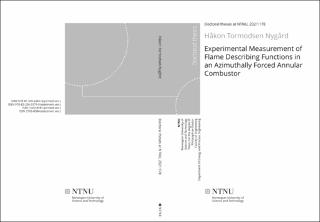| dc.contributor.advisor | Worth, Nicholas | |
| dc.contributor.advisor | Dawson, James | |
| dc.contributor.author | Nygård, Håkon Tormodsen | |
| dc.date.accessioned | 2021-05-20T08:30:56Z | |
| dc.date.available | 2021-05-20T08:30:56Z | |
| dc.date.issued | 2021 | |
| dc.identifier.isbn | 978-82-326-5379-9 | |
| dc.identifier.issn | 2703-8084 | |
| dc.identifier.uri | https://hdl.handle.net/11250/2755792 | |
| dc.description.abstract | Thermoacoustic instabilities have become an increasingly relevant issue in the search for lower emissions in gas turbines, both for power production and transportation. Adoption of alternative fuels in land based gas turbines can reduce CO2 emissions, and NOx emissions can be reduced by operating in a lean burn regime. Both approaches can make gas turbine engines more prone to exhibit self-excited thermoacoustic instabilities. Therefore, to increase the fuel and operational flexibility of gas turbines, a better understanding of thermoacoustic instabilities is required.
A promising approach to predict the stability of a new gas turbine design is to use low order models in conjunction with experimentally obtained flame transfer functions on axially perturbed single flame setups. This approach would greatly reduce the cost of the design process, allowing for a range of geometries to be numerically evaluated. However, practical configurations often have an annular geometry, where the azimuthal pressure mode is commonly the unstable mode. This is in contrast to the axially forced single flames used for defining the flame transfer function. Therefore, it is important to know if there are potential differences between the response of a single flame to axial perturbations and flames arranged in an annulus subjected to azimuthal pressure modes.
The aim of this thesis is to improve our understanding of the flame response in an annular combustor. The first step to achieve this is to create a reference case equivalent to a conventional axially perturbed single flame. One of the flames from an annular combustor is therefore isolated and studied in detail for a large range of operating conditions in an enclosure similar to one sector in the annular combustor. The response of the flame is characterised over a large range of frequencies, and the relevant time scales are extracted by fitting distributed time delay models. The response is observed to depend on the effective confinement of the flame, suppressing the expected dip behaviour for sufficiently long flames.
The second step is to study the response of an annular combustor to different azimuthal pressure modes in detail. To be able to study this, azimuthal forcing is applied to vary the amplitude, spinning state, and the orientation of the first azimuthal mode. The first method to exhibit good control over the full parameter space is developed in the current work. Additionally, a novel rotation averaging technique and the concept of Azimuthal Flame Describing Functions are introduced, allowing for efficient isolation of the flame response to different forced states and clear description of the main features. The different pressure mode types are shown to produce different responses for an annular combustor with coswirling flames. The differences are attributed to the local symmetry breaking created by the finite width annulus in combination with swirling flames. By removing the swirl, the local reflectional symmetry is restored, and the heat release rate pattern is observed to have reflectional symmetry for the two spinning directions. The difference in response for the annular combustor with swirling flames resulted in several interesting features, including a non-negligible heat release rate at the pressure node. Additionally, numerical simulations showed the difference in response results in a strong spinning direction preference for the pressure mode under selfexcited conditions. The understanding gained here will help the development of practical combustors, enabling the wider use of low emission technology. | en_US |
| dc.language.iso | eng | en_US |
| dc.publisher | NTNU | en_US |
| dc.relation.ispartofseries | Doctoral theses at NTNU;2021:178 | |
| dc.relation.haspart | Paper 1: Nygård, Håkon Tormodsen; Worth, Nicholas. Flame Transfer Functions and Dynamics of a Closely Confined Premixed Bluff Body Stabilised Flame With Swirl. 2021). Journal of Engineering for Gas Turbines and Power, 143(4):041011. | en_US |
| dc.relation.haspart | Paper 2: Nygård, Håkon Tormodsen; Mazur, Marek; Dawson, James; Worth, Nicholas. Flame dynamics of azimuthal forced spinning and standing modes in an annular combustor. Proceedings of the Combustion Institute 2019 ;Volum 37.(4) s. 5113-5120 | en_US |
| dc.relation.haspart | Paper 3: Mazur, Marek; Nygård, Håkon Tormodsen; Dawson, James; Worth, Nicholas. Characteristics of self-excited spinning azimuthal modes in an annular combustor with turbulent premixed bluff-body flames. Proceedings of the Combustion Institute 2019 ;Volum 37.(4) s. 5129-5136 | en_US |
| dc.relation.haspart | Paper 4: Nygård, Håkon Tormodsen; Ghirardo, Giulio; Worth, Nicholas. Azimuthal flame response and symmetry breaking in a forced annular combustor. This article is awaiting publication and is therefore not included. | en_US |
| dc.relation.haspart | Paper 5: Ghirardo, Giulio; Nygård, Håkon Tormodsen; Cuquel, Alexis; Worth, Nicholas. Symmetry breaking modelling for azimuthal combustion dynamics. Proceedings of the Combustion Institute 2021 ; p38(4):5953–5962. | en_US |
| dc.title | Experimental Measurement of Flame Describing Functions in an Azimuthally Forced Annular Combustor | en_US |
| dc.type | Doctoral thesis | en_US |
| dc.subject.nsi | VDP::Teknologi: 500 | en_US |

